Coding with golang
0 likes459 views
Join us to learn the basics of Go, a Google created language with strong concurrent features, and build a Discord bot!
1 of 34
Downloaded 10 times




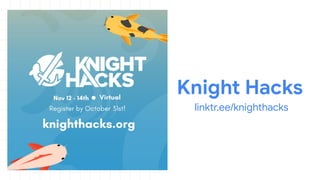

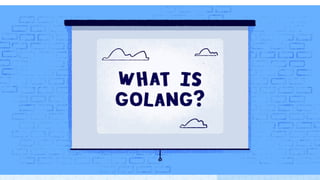


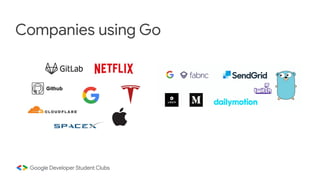
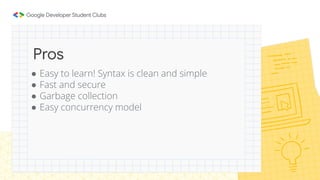



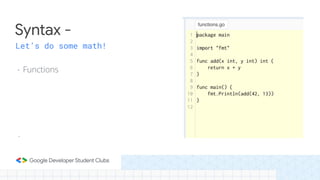







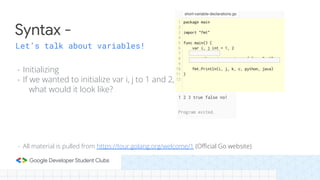






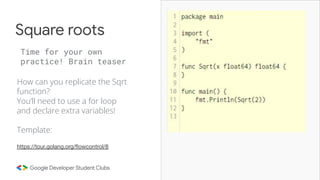




Ad
Recommended
Go Programming language, golang



Go Programming language, golangBasil N G The document provides an overview of the Go programming language. It discusses that Go was designed by Google to help solve their large-scale programming problems. It then summarizes Go's history, purpose, features, and syntax elements such as data types, operators, functions, concurrency using goroutines and channels. The document also provides examples of Go code and concludes that Go has emerged as a popular language for cloud infrastructure due to its simplicity, concurrency, and performance.
Go. Why it goes



Go. Why it goesSergey Pichkurov New language from Google, static safe compiler, with GC and as fast as C++ or Java, syntax simpler then Python - 2 hour-long tutorial and you can start code.
In this talk Serhii will talk about Go, also known as Golang – an open source language developed at Google and used in production by companies such as Docker, Dropbox, Facebook and Google itself. Go is now heavily used as a general-purpose programming language that’s a pleasure to use and maintain. This introductory talk contains many live demos of basic language concepts, concurrency model, simple HTTP-based endpoint implementation and, of course, tests using build-in framework. This presentation will be interesting for backend engineers and DevOps to understand why Go had become so popular and how it might help to build robust and maintanable services.
Agenda of the presentation:
1. Go is not C, not Java, not anything
2. Rob Pike argument
3. Main ideas and basics
4. Concurrency model
5. Tools
6. Issues
Golang 101



Golang 101宇 傅 The document provides an introduction to the Go programming language. Some key points:
- Go was designed by Google to handle large scale software development with thousands of developers and machines. It focuses on concurrency, simplicity, and reliability.
- Some core features of Go include goroutines for lightweight threads, channels for communication between goroutines, and interfaces for abstraction.
- Go aims to compile quickly to machine code for performance and packages into single binaries for easy deployment.
- The document demonstrates building a basic web server in Go and encourages hands-on learning through its tour and examples.
The Go programming language - Intro by MyLittleAdventure



The Go programming language - Intro by MyLittleAdventuremylittleadventure The document discusses the Go programming language, providing information on its history, creators at Google, design goals, key characteristics like being statically typed and concurrent, benchmarking results, major companies using Go, and examples of using Go for web scraping and servers. It outlines pros and cons of Go and resources for learning more.
Introduction to go lang



Introduction to go langAmal Mohan N Introduction to GoLang by Amal Mohan N. This presentation is an introduction to GoLang - it's history, features, syntax, importance etc.
concurrency, go-routines, golang, google, gopher, introduction, programming
Why you should care about Go (Golang)



Why you should care about Go (Golang)Aaron Schlesinger The document discusses why the Go programming language is gaining popularity and why it is well-suited for cloud and microservices environments. Go provides efficient concurrency through goroutines and channels, which makes it productive for building scalable distributed systems. Its simple installation process and tooling also improve developer productivity. The document predicts that Go usage will continue growing as it becomes more widely adopted for cloud applications.
Go lang



Go langSuelen Carvalho Go is a programming language created by Google to help solve problems with large software and hardware systems. It was designed to facilitate development of large codebases by many engineers. Some key problems it aimed to address were slowness, clumsiness and lack of productivity in other languages like C++. Go provides features like garbage collection, concurrency with goroutines and channels, and a standard library, while remaining simple and compiled. It grew from a small project at Google into an open source language adopted by many organizations.
Introduction to GoLang



Introduction to GoLangNVISIA This document provides guidance on designing microservices using the Go programming language. It begins with an introduction to Go's core concepts like packages, functions, methods, structs, interfaces, errors, goroutines, and what Go does not include. It then discusses when Go is well-suited and not well-suited through examples. The document concludes with tips for designing Go microservices, including leveraging existing frameworks, using interfaces, ORM for entities, centralizing configurations, and making errors meaningful. The overall message is to understand where Go works best and mix technologies as needed while avoiding unnecessary complexity.
Go language presentation



Go language presentationparamisoft The document discusses the Go programming language and why it was created. It provides several key points:
- Go was created over a decade since a new major systems language emerged, and the computing landscape has changed significantly in areas like software development speed, dependency management, type systems, garbage collection, and parallelism.
- Go aims to address these changes with a compiled, garbage-collected language that provides fast compilation, easy dependency analysis, lightweight static types, built-in support for concurrency and communication on multicore systems.
- Some of Go's guiding principles in design were to reduce typing, clutter, and complexity while avoiding forward declarations and header files everything is declared once without type hierarchies.
Golang - Overview of Go (golang) Language



Golang - Overview of Go (golang) LanguageAniruddha Chakrabarti Go is a statically typed, compiled programming language designed for building simple, reliable, and efficient software. Some key points:
- Go is natively compiled and uses static typing with type inference. It is targeted for system programming and server-side applications.
- It was created at Google in 2007 to address issues with other languages like dependency management, garbage collection, and support for concurrency.
- Popular users include Google, Docker, Dropbox, SoundCloud, and MongoDB. Domains it is used include distributed systems, cloud, web development, and systems programming.
- Key features include built-in concurrency and networking support, a rich standard library, and fast compilation. It aims to be
Go Programming Language by Google



Go Programming Language by GoogleUttam Gandhi Go is a programming language created by Google that aims to be a simple, efficient, and concurrent language. The document provides an overview of the history and features of Go, including its support for garbage collection, concurrency, and ease of programming. Examples are given demonstrating how to write Go code, use interfaces and channels for concurrency, and connect to MongoDB. The document also lists several companies that use Go in production applications.
Go Concurrency



Go Concurrencyjgrahamc This document discusses Go concurrency fundamentals including goroutines, channels, and synchronization primitives. It provides examples of using goroutines and channels for signaling between processes, timeouts, heartbeats, and implementing a load balancer. Key points covered include goroutines being lightweight processes, channel-based communication between goroutines, and using select to handle multiple channel operations.
Golang



GolangFelipe Mamud Go is an open source programming language designed by Google to be concurrent, garbage collected, and efficient. It has a simple syntax and is used by Google and others to build large distributed systems. Key features include garbage collection, concurrency with goroutines and channels, interfaces without inheritance, and a large standard library.
GoLang Introduction



GoLang IntroductionSpandana Govindgari Go is a statically-typed, compiled programming language developed by Google. It aims for fast build times and single binary deployments. Go emphasizes concurrency through lightweight goroutines and channels for communication between them. While it lacks some object-oriented features like inheritance, it provides built-in support for concurrency and parallelism which makes it well-suited for backend services, network applications, and processing large amounts of data.
Golang



GolangSoftware Infrastructure GoLang is an open source programming language created by Google in 2009. It has a large community and was designed for scalability and concurrency. Some key features include being statically typed, compiled, and having built-in support for concurrency through goroutines and channels. Google uses GoLang extensively to build systems that scale to thousands of machines.
Golang workshop



Golang workshopVictor S. Recio The program uses a for loop to iterate from 1 to 100. Inside the loop, it uses if/else conditions to check if the number is divisible by 3, 5, or both and prints the corresponding string. If none of the conditions are met, it prints the number.
Introduction to Go programming language



Introduction to Go programming languageSlawomir Dorzak This document provides an introduction to the Go programming language. It discusses Go's history, syntax, types, control structures, functions, interfaces, concurrency features using goroutines and channels, and some examples. Key points are that Go was created at Google in 2007 for ease of programming, type safety, memory safety, and concurrency. It has similarities to C syntax but is garbage collected and uses channels for communicating between goroutines.
Go Language presentation



Go Language presentationGh-Mohammed Eldadah Go is a compiled, concurrent, garbage-collected, statically typed language developed at Google in 2007 to address issues with large software systems. It was created to facilitate easy memory management, enable rapid compilation, and handle concurrency through built-in goroutines and channels. Many large companies now use Go for its improved developer productivity compared to other languages.
Introduction to go language programming



Introduction to go language programmingMahmoud Masih Tehrani Introduction to go language programming , benchmark with another language programming nodejs , php , ruby & python . how install go . use what IDE . and rapid learnin golang
Go Lang Tutorial



Go Lang TutorialWei-Ning Huang - Go is a programming language created at Google. It is fast, statically typed, and has garbage collection.
- The tutorial covers Go's history, why it was created, library support, and provides examples of variables, functions, flow control, methods, interfaces, and goroutines.
- The document includes an outline, code examples throughout to demonstrate the concepts, and references additional resources for learning Go.
Golang (Go Programming Language)



Golang (Go Programming Language)ShubhamMishra485 Go, Golang, Golnguage, what is go language, what is go, History of go, Founders of Go, Why Go is invented ?, Why Go?, Who are using go today?, What will you see in Go?, What will you not see in Go?, Structure of Go Programs, Features of Go, Drawbacks of Go
Write microservice in golang



Write microservice in golangBo-Yi Wu * What are Microservices?
* Why Microservices?
* Golang Introduction
* Golang Testing Tool
* Golang Deployment with Docker
Introduction to Go language



Introduction to Go languageTzar Umang A primer to Google's Go Language, the presentation is designed to help kickstart developers to use the new language.
Golang Template



Golang TemplateKarthick Kumar Templates are a way to merge generic text with more specific text
Example : ERB / Haml – Template Engine for Ruby
An introduction to programming in Go



An introduction to programming in GoDavid Robert Camargo de Campos Go is an open source programming language developed at Google to build simple, reliable and efficient software. It is a compiled, concurrent language that makes it easy to build scalable network and web applications. Some key features of Go include garbage collection, static typing, concurrency support with goroutines, and a large standard library. Go aims to combine the efficiency and speed of compiled languages like C with the simplicity and ease of dynamic languages.
Golang and Eco-System Introduction / Overview



Golang and Eco-System Introduction / OverviewMarkus Schneider Content:
- Why Go?
- Some facts about Go
- Important Aspects
- Command / Syntax Tour
- Eco-System
- Summary
- References
Golang getting started



Golang getting startedHarshad Patil Go is a statically-typed, garbage-collected programming language that is fast, supports concurrency, and has built-in support for remote package management. It is well-suited for building network servers and applications with non-blocking I/O. The document provides examples of writing a simple "Hello World" program, building a basic HTTP server, and using goroutines for concurrency. It also outlines how to install Go, set up a development environment, and find additional learning resources.
Concurrency With Go



Concurrency With GoJohn-Alan Simmons A talk I gave at the Golang TO Meetup. Highlighting the beautiful powers of Go with respect to concurrency, and writing concurrent programs using it.
Code at: github.com/jsimnz/concurrency-talk
Getting started with go - Florin Patan - Codemotion Milan 2016



Getting started with go - Florin Patan - Codemotion Milan 2016Codemotion This talk focuses on people which are interested the Go programming language and want to learn it. In it I will present the various resources new gophers have to learn Go, what are the usual pitfalls and how to get help when they are stuck.
Getting started with Go - Florin Patan - Codemotion Rome 2017



Getting started with Go - Florin Patan - Codemotion Rome 2017Codemotion This talk focuses on people which are interested the Go programming language and want to learn it. In it I will present the various resources new gophers have to learn Go, what are the usual pitfalls and how to get help when they are stuck.
Ad
More Related Content
What's hot (20)
Go language presentation



Go language presentationparamisoft The document discusses the Go programming language and why it was created. It provides several key points:
- Go was created over a decade since a new major systems language emerged, and the computing landscape has changed significantly in areas like software development speed, dependency management, type systems, garbage collection, and parallelism.
- Go aims to address these changes with a compiled, garbage-collected language that provides fast compilation, easy dependency analysis, lightweight static types, built-in support for concurrency and communication on multicore systems.
- Some of Go's guiding principles in design were to reduce typing, clutter, and complexity while avoiding forward declarations and header files everything is declared once without type hierarchies.
Golang - Overview of Go (golang) Language



Golang - Overview of Go (golang) LanguageAniruddha Chakrabarti Go is a statically typed, compiled programming language designed for building simple, reliable, and efficient software. Some key points:
- Go is natively compiled and uses static typing with type inference. It is targeted for system programming and server-side applications.
- It was created at Google in 2007 to address issues with other languages like dependency management, garbage collection, and support for concurrency.
- Popular users include Google, Docker, Dropbox, SoundCloud, and MongoDB. Domains it is used include distributed systems, cloud, web development, and systems programming.
- Key features include built-in concurrency and networking support, a rich standard library, and fast compilation. It aims to be
Go Programming Language by Google



Go Programming Language by GoogleUttam Gandhi Go is a programming language created by Google that aims to be a simple, efficient, and concurrent language. The document provides an overview of the history and features of Go, including its support for garbage collection, concurrency, and ease of programming. Examples are given demonstrating how to write Go code, use interfaces and channels for concurrency, and connect to MongoDB. The document also lists several companies that use Go in production applications.
Go Concurrency



Go Concurrencyjgrahamc This document discusses Go concurrency fundamentals including goroutines, channels, and synchronization primitives. It provides examples of using goroutines and channels for signaling between processes, timeouts, heartbeats, and implementing a load balancer. Key points covered include goroutines being lightweight processes, channel-based communication between goroutines, and using select to handle multiple channel operations.
Golang



GolangFelipe Mamud Go is an open source programming language designed by Google to be concurrent, garbage collected, and efficient. It has a simple syntax and is used by Google and others to build large distributed systems. Key features include garbage collection, concurrency with goroutines and channels, interfaces without inheritance, and a large standard library.
GoLang Introduction



GoLang IntroductionSpandana Govindgari Go is a statically-typed, compiled programming language developed by Google. It aims for fast build times and single binary deployments. Go emphasizes concurrency through lightweight goroutines and channels for communication between them. While it lacks some object-oriented features like inheritance, it provides built-in support for concurrency and parallelism which makes it well-suited for backend services, network applications, and processing large amounts of data.
Golang



GolangSoftware Infrastructure GoLang is an open source programming language created by Google in 2009. It has a large community and was designed for scalability and concurrency. Some key features include being statically typed, compiled, and having built-in support for concurrency through goroutines and channels. Google uses GoLang extensively to build systems that scale to thousands of machines.
Golang workshop



Golang workshopVictor S. Recio The program uses a for loop to iterate from 1 to 100. Inside the loop, it uses if/else conditions to check if the number is divisible by 3, 5, or both and prints the corresponding string. If none of the conditions are met, it prints the number.
Introduction to Go programming language



Introduction to Go programming languageSlawomir Dorzak This document provides an introduction to the Go programming language. It discusses Go's history, syntax, types, control structures, functions, interfaces, concurrency features using goroutines and channels, and some examples. Key points are that Go was created at Google in 2007 for ease of programming, type safety, memory safety, and concurrency. It has similarities to C syntax but is garbage collected and uses channels for communicating between goroutines.
Go Language presentation



Go Language presentationGh-Mohammed Eldadah Go is a compiled, concurrent, garbage-collected, statically typed language developed at Google in 2007 to address issues with large software systems. It was created to facilitate easy memory management, enable rapid compilation, and handle concurrency through built-in goroutines and channels. Many large companies now use Go for its improved developer productivity compared to other languages.
Introduction to go language programming



Introduction to go language programmingMahmoud Masih Tehrani Introduction to go language programming , benchmark with another language programming nodejs , php , ruby & python . how install go . use what IDE . and rapid learnin golang
Go Lang Tutorial



Go Lang TutorialWei-Ning Huang - Go is a programming language created at Google. It is fast, statically typed, and has garbage collection.
- The tutorial covers Go's history, why it was created, library support, and provides examples of variables, functions, flow control, methods, interfaces, and goroutines.
- The document includes an outline, code examples throughout to demonstrate the concepts, and references additional resources for learning Go.
Golang (Go Programming Language)



Golang (Go Programming Language)ShubhamMishra485 Go, Golang, Golnguage, what is go language, what is go, History of go, Founders of Go, Why Go is invented ?, Why Go?, Who are using go today?, What will you see in Go?, What will you not see in Go?, Structure of Go Programs, Features of Go, Drawbacks of Go
Write microservice in golang



Write microservice in golangBo-Yi Wu * What are Microservices?
* Why Microservices?
* Golang Introduction
* Golang Testing Tool
* Golang Deployment with Docker
Introduction to Go language



Introduction to Go languageTzar Umang A primer to Google's Go Language, the presentation is designed to help kickstart developers to use the new language.
Golang Template



Golang TemplateKarthick Kumar Templates are a way to merge generic text with more specific text
Example : ERB / Haml – Template Engine for Ruby
An introduction to programming in Go



An introduction to programming in GoDavid Robert Camargo de Campos Go is an open source programming language developed at Google to build simple, reliable and efficient software. It is a compiled, concurrent language that makes it easy to build scalable network and web applications. Some key features of Go include garbage collection, static typing, concurrency support with goroutines, and a large standard library. Go aims to combine the efficiency and speed of compiled languages like C with the simplicity and ease of dynamic languages.
Golang and Eco-System Introduction / Overview



Golang and Eco-System Introduction / OverviewMarkus Schneider Content:
- Why Go?
- Some facts about Go
- Important Aspects
- Command / Syntax Tour
- Eco-System
- Summary
- References
Golang getting started



Golang getting startedHarshad Patil Go is a statically-typed, garbage-collected programming language that is fast, supports concurrency, and has built-in support for remote package management. It is well-suited for building network servers and applications with non-blocking I/O. The document provides examples of writing a simple "Hello World" program, building a basic HTTP server, and using goroutines for concurrency. It also outlines how to install Go, set up a development environment, and find additional learning resources.
Concurrency With Go



Concurrency With GoJohn-Alan Simmons A talk I gave at the Golang TO Meetup. Highlighting the beautiful powers of Go with respect to concurrency, and writing concurrent programs using it.
Code at: github.com/jsimnz/concurrency-talk
Similar to Coding with golang (20)
Getting started with go - Florin Patan - Codemotion Milan 2016



Getting started with go - Florin Patan - Codemotion Milan 2016Codemotion This talk focuses on people which are interested the Go programming language and want to learn it. In it I will present the various resources new gophers have to learn Go, what are the usual pitfalls and how to get help when they are stuck.
Getting started with Go - Florin Patan - Codemotion Rome 2017



Getting started with Go - Florin Patan - Codemotion Rome 2017Codemotion This talk focuses on people which are interested the Go programming language and want to learn it. In it I will present the various resources new gophers have to learn Go, what are the usual pitfalls and how to get help when they are stuck.
Golang



GolangSaray Chak Go is a compiled, concurrent, garbage-collected programming language developed at Google. It aims to combine the performance and low-level access of compiled languages with the ease of use of scripting languages. Some key features of Go include its simple syntax, static and strong typing, concurrency support through goroutines and channels, and automatic memory management through garbage collection. Go is used by many companies and has a large standard library, though it lacks some common features like inheritance.
Mobile Apps by Pure Go with Reverse Binding



Mobile Apps by Pure Go with Reverse BindingTakuya Ueda This document discusses developing Android apps in Go using the gomobile tool. It covers cross-compiling Go code for Android, using cgo to access Android platform APIs, and developing both SDK and native Android apps in Go. It then describes how gomobile bind can generate bindings between Go and Java to allow accessing Android platform APIs from Go code through reverse bindings. This allows writing fully native Android apps directly in Go.
Me&g@home 



Me&g@home Vytautas Dauksa My first presentation at Perl conference, where I introduced myself to wider Perl community and talked about Google@Home project ( https://github.com/IntelliHome/Google-at-Home ).
Go for Mobile Games



Go for Mobile GamesTakuya Ueda I talked this presentation in GopherCon 2016.
Go Mobile (golang.org/x/mobile) is a project which shows new possibilities for mobile apps development.
Especially, for mobile games which requires high performance processing, Go can be expected to be an alternative to C and C++.
This session explains how to develop game apps using some packages such as app, event and sprite provided by Go Mobile project.
Furthermore the session introduces a way to call Android API from Go codes, and solutions for some problems which occurs when we distribute apps on Google Play.
I would like to show current capabilities and future potentials of Go Mobile.
iTHome Gopher Day 2017: What can Golang do? (Using project 52 as examples)



iTHome Gopher Day 2017: What can Golang do? (Using project 52 as examples)Evan Lin 入手一個新的語言永遠不是一件簡單的事情。
不論是要學習 toolset 跟語言的語法,一直以來在過程中最大的問題永遠都會是:這個語言究竟能做些什麼?
講者曾經在 2015/06~ 2016/06 一年中挑戰自己每個禮拜寫一個小的專案,名為 "Project 52" 。透過 "Project 52",講者會告訴你,究竟 Golang 能做些什麼:
簡潔的語法
強大的工具鏈
超高的效能
Google 開發出的 Golang 不僅僅能讓你更專注開發,還能幫助你開發高效的應用程式。
Adopt OpenJDK presentation (slide deck)



Adopt OpenJDK presentation (slide deck)Mani Sarkar This document summarizes a presentation about Adopt OpenJDK, an initiative to improve the OpenJDK and Java. It discusses what OpenJDK is, the benefits of contributing to it, and how to get involved at different levels, from testing to more advanced work. The presenter encourages attendees to consider joining the effort to help advance the Java ecosystem. Slides and demos are provided during the presentation, and time is allocated at the end for questions, announcements and discussion.
Feelin' Groovy: A Groovy Developer in the Java World



Feelin' Groovy: A Groovy Developer in the Java WorldKen Kousen Keynote given at Gr8conf.in, Delhi, India, January 2017. Variation of same keynote given at Gr8conf.eu in Copenhagen (https://www.youtube.com/watch?v=KZ7u8CddgnI) and Gr8conf.us in Minneapolis, earlier in 2016
The case for Web components - Drupal4Gov webinar



The case for Web components - Drupal4Gov webinarbtopro This is the presentation I gave to the Drupal4Gov community on web components in government. Why the time is right to begin looking at them for future adoption, how to get more information, what they've done for our team and process, who's using them, etc. It's a great starting point to browse through and get a sense of who's using them and what the implications are.
Develop Android/iOS app using golang



Develop Android/iOS app using golangSeongJae Park The document discusses using Golang for mobile application development. It provides an example of building a pure Golang Android app without Java by compiling Golang code to a shared object library and using the NativeActivity. It also provides an example of using Golang as a library in a Java Android app by generating bindings between Golang and Java code. Additionally, it proposes an approach for running a standalone Golang process on Android by cross-compiling Golang code to ARM/Linux and executing it from an Android app.
The webs and it's future.



The webs and it's future.Gbolahan Alli This document discusses the future of the web and how developers can get involved. It notes that every second millions of activities occur online like tweets, Instagram posts, and Google searches. It then asks how individuals can get involved and notes that Facebook and Google started small. It discusses web browsers, programming languages, and collaboration tools that developers use. It encourages attending local developer communities and provides resources for learning Git and GitHub to get started contributing to open source projects online.
Android is going to Go! - Android and goland - Almog Baku



Android is going to Go! - Android and goland - Almog BakuDroidConTLV This document discusses using the Go programming language for Android development. It begins with an introduction to Go, showing basic "Hello World" examples. It then demonstrates how to use goroutines for concurrency, channels for communication between goroutines, and Go's standard library features. The document introduces Go Mobile, a tool for building native Android and iOS apps and libraries entirely in Go. It provides examples of creating native Go apps and Go libraries that interface with Java/Swift through bindings. In the end, it discusses some disadvantages of the Go mobile approach.
Android is going to Go! Android and Golang



Android is going to Go! Android and GolangAlmog Baku I recently talked in Droidcon about building using Go with Android
We talked about what is Go? And why it's so awesome? And how can we use it with Android?
On this session we've learnt a little bit about Go, and how can we use it with Android- about the use cases, and the secret
tricks to use it with mobile applications.
Javascript as a target language - GWT kickoff - part1/2



Javascript as a target language - GWT kickoff - part1/2JooinK This document summarizes a presentation about Google Web Toolkit (GWT) given by Alberto Mancini and Francesca Tosi. It discusses what GWT is, provides statistics on its usage and popularity, explores why developers use GWT and its benefits, and gives examples of using GWT with computer vision libraries to enable augmented reality applications in the browser.
Develop Android app using Golang



Develop Android app using GolangSeongJae Park This document summarizes different approaches for using the Go programming language to build Android applications. It discusses building a pure Go app using the NativeActivity class, integrating Go as a library using bindings, and spawning separate Go processes from an Android app using inter-process communication. Code examples are provided for each approach. While Go support for Android is still unstable, these techniques allow Go to be used for simple Android projects as an alternative to Java.
Using Go in DevOps



Using Go in DevOpsEficode Natalie Pistunovich
Engineering Manager – Fraugster
Natalie is an Engineering Manager, Go Developer, Berlin’s Go User Group Lead, GopherCon Europe organizer and Public Speaker. She also describes herself as a Passionate Learner and Professional Questions Asker.
Natalie Pistunovich - Using Go In Dev Ops



Natalie Pistunovich - Using Go In Dev OpsFraugster This document discusses using the Go programming language for DevOps tools and applications. It begins with an introduction to Go, highlighting its benefits for system and site reliability engineering like being simple, reliable, and efficient. It then covers several existing open source DevOps tools built in Go, such as monitoring and logging programs. Finally, it discusses the growing adoption of Go and future developments like Go 2.0, noting how the Go community has doubled in size recently.
Google Assistant Overview 



Google Assistant Overview AI.academy 台灣人工智慧小聚
https://www.facebook.com/groups/datasci.dinner/
台灣人工智慧小聚 - Taipei#20190823
https://aiacademy.neticrm.tw/civicrm/event/info?reset=1&id=71
【講者2:林建宏 Wolke Lin】
台灣 8 位 LAE (LINE API EXPERT)之一 、亞太 4 位 Assistant GDE(Google Developer Expert) 之一。專長軟體工程、系統開發、技術文件寫作、教育訓練,喜好研究程式語言、框架、社群,從中學習設計,目前以node.js 開發前後台及智能語音應用/聊天機器人為主。
【Google Assistant Overview】
本次講題將介紹 Google Assistant 目前的狀況、未來展望、及目前全球和台灣的相關應用。Google在2016年發布了Google Asisitant服務,至今有3年的時間,從一開始支援14國8種語言,到現在80國30種語言;從必須在雲端執行的100GB資料量,縮小到可放在手機執行的0.5GB資料量。從手機、電腦、Smart Home各種面向,Google Asisitant將怎麼影響我們未來的生活?身為一個開發者,又有哪些機會?讓我們一同來探討!
Oracle GoldenGate Studio Intro



Oracle GoldenGate Studio IntroBobby Curtis This document summarizes a presentation about the Next Generation of Oracle GoldenGate Design. It introduces Oracle's new design tool, Oracle GoldenGate Studio, which allows users to quickly design simple and robust data replication architectures in a graphical interface. It then provides a walkthrough of the key features of Oracle GoldenGate Studio, including the design panel, projects, resources, deployment profiles, parameter files, and direct deployment capabilities. It concludes with some best practices and known bugs.
Ad
Recently uploaded (20)
Transcript: #StandardsGoals for 2025: Standards & certification roundup - Tec...



Transcript: #StandardsGoals for 2025: Standards & certification roundup - Tec...BookNet Canada Book industry standards are evolving rapidly. In the first part of this session, we’ll share an overview of key developments from 2024 and the early months of 2025. Then, BookNet’s resident standards expert, Tom Richardson, and CEO, Lauren Stewart, have a forward-looking conversation about what’s next.
Link to recording, presentation slides, and accompanying resource: https://bnctechforum.ca/sessions/standardsgoals-for-2025-standards-certification-roundup/
Presented by BookNet Canada on May 6, 2025 with support from the Department of Canadian Heritage.
How analogue intelligence complements AI



How analogue intelligence complements AIPaul Rowe
Artificial Intelligence is providing benefits in many areas of work within the heritage sector, from image analysis, to ideas generation, and new research tools. However, it is more critical than ever for people, with analogue intelligence, to ensure the integrity and ethical use of AI. Including real people can improve the use of AI by identifying potential biases, cross-checking results, refining workflows, and providing contextual relevance to AI-driven results.
News about the impact of AI often paints a rosy picture. In practice, there are many potential pitfalls. This presentation discusses these issues and looks at the role of analogue intelligence and analogue interfaces in providing the best results to our audiences. How do we deal with factually incorrect results? How do we get content generated that better reflects the diversity of our communities? What roles are there for physical, in-person experiences in the digital world?
TrsLabs - Fintech Product & Business Consulting



TrsLabs - Fintech Product & Business ConsultingTrs Labs Hybrid Growth Mandate Model with TrsLabs
Strategic Investments, Inorganic Growth, Business Model Pivoting are critical activities that business don't do/change everyday. In cases like this, it may benefit your business to choose a temporary external consultant.
An unbiased plan driven by clearcut deliverables, market dynamics and without the influence of your internal office equations empower business leaders to make right choices.
Getting things done within a budget within a timeframe is key to Growing Business - No matter whether you are a start-up or a big company
Talk to us & Unlock the competitive advantage
Rusty Waters: Elevating Lakehouses Beyond Spark



Rusty Waters: Elevating Lakehouses Beyond Sparkcarlyakerly1 Spark is a powerhouse for large datasets, but when it comes to smaller data workloads, its overhead can sometimes slow things down. What if you could achieve high performance and efficiency without the need for Spark?
At S&P Global Commodity Insights, having a complete view of global energy and commodities markets enables customers to make data-driven decisions with confidence and create long-term, sustainable value. 🌍
Explore delta-rs + CDC and how these open-source innovations power lightweight, high-performance data applications beyond Spark! 🚀
Mobile App Development Company in Saudi Arabia



Mobile App Development Company in Saudi ArabiaSteve Jonas EmizenTech is a globally recognized software development company, proudly serving businesses since 2013. With over 11+ years of industry experience and a team of 200+ skilled professionals, we have successfully delivered 1200+ projects across various sectors. As a leading Mobile App Development Company In Saudi Arabia we offer end-to-end solutions for iOS, Android, and cross-platform applications. Our apps are known for their user-friendly interfaces, scalability, high performance, and strong security features. We tailor each mobile application to meet the unique needs of different industries, ensuring a seamless user experience. EmizenTech is committed to turning your vision into a powerful digital product that drives growth, innovation, and long-term success in the competitive mobile landscape of Saudi Arabia.
Splunk Security Update | Public Sector Summit Germany 2025



Splunk Security Update | Public Sector Summit Germany 2025Splunk Splunk Security Update
Sprecher: Marcel Tanuatmadja
tecnologias de las primeras civilizaciones.pdf



tecnologias de las primeras civilizaciones.pdffjgm517 descaripcion detallada del avance de las tecnologias en mesopotamia, egipto, roma y grecia.
Cybersecurity Identity and Access Solutions using Azure AD



Cybersecurity Identity and Access Solutions using Azure ADVICTOR MAESTRE RAMIREZ Cybersecurity Identity and Access Solutions using Azure AD
DevOpsDays Atlanta 2025 - Building 10x Development Organizations.pptx



DevOpsDays Atlanta 2025 - Building 10x Development Organizations.pptxJustin Reock Building 10x Organizations with Modern Productivity Metrics
10x developers may be a myth, but 10x organizations are very real, as proven by the influential study performed in the 1980s, ‘The Coding War Games.’
Right now, here in early 2025, we seem to be experiencing YAPP (Yet Another Productivity Philosophy), and that philosophy is converging on developer experience. It seems that with every new method we invent for the delivery of products, whether physical or virtual, we reinvent productivity philosophies to go alongside them.
But which of these approaches actually work? DORA? SPACE? DevEx? What should we invest in and create urgency behind today, so that we don’t find ourselves having the same discussion again in a decade?
Manifest Pre-Seed Update | A Humanoid OEM Deeptech In France



Manifest Pre-Seed Update | A Humanoid OEM Deeptech In Francechb3 The latest updates on Manifest's pre-seed stage progress.
What is Model Context Protocol(MCP) - The new technology for communication bw...



What is Model Context Protocol(MCP) - The new technology for communication bw...Vishnu Singh Chundawat The MCP (Model Context Protocol) is a framework designed to manage context and interaction within complex systems. This SlideShare presentation will provide a detailed overview of the MCP Model, its applications, and how it plays a crucial role in improving communication and decision-making in distributed systems. We will explore the key concepts behind the protocol, including the importance of context, data management, and how this model enhances system adaptability and responsiveness. Ideal for software developers, system architects, and IT professionals, this presentation will offer valuable insights into how the MCP Model can streamline workflows, improve efficiency, and create more intuitive systems for a wide range of use cases.
The Evolution of Meme Coins A New Era for Digital Currency ppt.pdf



The Evolution of Meme Coins A New Era for Digital Currency ppt.pdfAbi john Analyze the growth of meme coins from mere online jokes to potential assets in the digital economy. Explore the community, culture, and utility as they elevate themselves to a new era in cryptocurrency.
Procurement Insights Cost To Value Guide.pptx



Procurement Insights Cost To Value Guide.pptxJon Hansen Procurement Insights integrated Historic Procurement Industry Archives, serves as a powerful complement — not a competitor — to other procurement industry firms. It fills critical gaps in depth, agility, and contextual insight that most traditional analyst and association models overlook.
Learn more about this value- driven proprietary service offering here.
Heap, Types of Heap, Insertion and Deletion



Heap, Types of Heap, Insertion and DeletionJaydeep Kale This pdf will explain what is heap, its type, insertion and deletion in heap and Heap sort
Massive Power Outage Hits Spain, Portugal, and France: Causes, Impact, and On...



Massive Power Outage Hits Spain, Portugal, and France: Causes, Impact, and On...Aqusag Technologies In late April 2025, a significant portion of Europe, particularly Spain, Portugal, and parts of southern France, experienced widespread, rolling power outages that continue to affect millions of residents, businesses, and infrastructure systems.
Semantic Cultivators : The Critical Future Role to Enable AI



Semantic Cultivators : The Critical Future Role to Enable AIartmondano By 2026, AI agents will consume 10x more enterprise data than humans, but with none of the contextual understanding that prevents catastrophic misinterpretations.
IEDM 2024 Tutorial2_Advances in CMOS Technologies and Future Directions for C...



IEDM 2024 Tutorial2_Advances in CMOS Technologies and Future Directions for C...organizerofv IEDM 2024 Tutorial2
Linux Professional Institute LPIC-1 Exam.pdf



Linux Professional Institute LPIC-1 Exam.pdfRHCSA Guru Introduction to LPIC-1 Exam - overview, exam details, price and job opportunities
Noah Loul Shares 5 Steps to Implement AI Agents for Maximum Business Efficien...



Noah Loul Shares 5 Steps to Implement AI Agents for Maximum Business Efficien...Noah Loul Artificial intelligence is changing how businesses operate. Companies are using AI agents to automate tasks, reduce time spent on repetitive work, and focus more on high-value activities. Noah Loul, an AI strategist and entrepreneur, has helped dozens of companies streamline their operations using smart automation. He believes AI agents aren't just tools—they're workers that take on repeatable tasks so your human team can focus on what matters. If you want to reduce time waste and increase output, AI agents are the next move.
What is Model Context Protocol(MCP) - The new technology for communication bw...



What is Model Context Protocol(MCP) - The new technology for communication bw...Vishnu Singh Chundawat
Ad
Coding with golang
- 1. Coding with Golang October 21st, 6-7PM Sign in
- 2. What is a GDSC? Google Developer Student Clubs
- 3. We’re open to all majors! If you would like to join GDSC at UCF, it’s easy! The linked slide deck has all of our socials, calendar, mailing list, a step-by-step guide on joining Bevy (our Google-created RSVP site), and more! tinyurl.com/gdsc-ucf-join-in Want to Join GDSC?
- 6. Meet today’s speakers Hannah Moss GDSC UCF - Lead/President Alice Yu GDSC UCF - VP/Co-Lead Andrei Gulapa GDSC UCF - Marketing Lead
- 8. What is Golang/ Go? ● Golang or..Go? ○ go.org was not available → golang.org! ○ “Golang” == “Go” (but the actual language is called Go!) ● Created by Google in 2007 ● Open source programming language
- 9. Uses
- 11. ● Easy to learn! Syntax is clean and simple ● Fast and secure ● Garbage collection ● Easy concurrency model Pros
- 12. ● No generics ● Poor library support ● Time-consuming to write Cons
- 13. Hello World! - Packages - Imports - Functions / main - All material is pulled from https://tour.golang.org/welcome/1 (Official Go website) Syntax -
- 14. Let’s do some math! - Imports - Exports - All material is pulled from https://tour.golang.org/welcome/1 (Official Go website) Syntax -
- 15. Let’s do some math! - Functions - Syntax -
- 16. Let’s do some math! - Shortened function parameters - Syntax -
- 17. Swappy swap - Multiple return types - All material is pulled from https://tour.golang.org/welcome/1 (Official Go website) Syntax -
- 18. Practice time! - Let’s code up a split number function! - Split the number 17 into 2 numbers - Syntax -
- 19. Practice time! - What is the return type? - Shorten this function’s return parameters - Syntax -
- 20. Practice time! - What is the return type? - Shorten this function’s return parameters - Syntax -
- 21. Let’s talk about variables! - Declaring - All material is pulled from https://tour.golang.org/welcome/1 (Official Go website) Syntax -
- 22. Let’s talk about variables! - Initializing - If we wanted to initialize var i, j to 1 and 2, what would it look like? - All material is pulled from https://tour.golang.org/welcome/1 (Official Go website) Syntax -
- 23. Let’s talk about variables! - Initializing - If we wanted to initialize var i, j to 1 and 2, what would it look like? - All material is pulled from https://tour.golang.org/welcome/1 (Official Go website) Syntax -
- 24. Let’s talk about variables! - Short var declarations - Used frequently - All material is pulled from https://tour.golang.org/welcome/1 (Official Go website) Syntax -
- 25. Loops - For loops - What does a typical for loop parameter look like for int i for (i < 10) comparisons? - What if we used a shortened var initialization to initialize i? What would it look like? Syntax -
- 26. Loops - For loops - All material is pulled from https://tour.golang.org/welcome/1 (Official Go website) Syntax -
- 27. Loops - While loop - Basically a shorted for loop - All material is pulled from https://tour.golang.org/welcome/1 (Official Go website) Syntax -
- 29. If statements You can shorten if statements that have preconditions Syntax -
- 30. How can you replicate the Sqrt function? You’ll need to use a for loop and declare extra variables! Template: Square roots Time for your own practice! Brain teaser https://tour.golang.org/flowcontrol/8
- 31. Discord Setup Steps - Overview 1. Set Up Discord Server 2. Create a new Discord Application - https://discord.com/developers/applications a. Create a new Discord Bot 3. Connect the Bot to your Server Let’s Dive in!! Let’s Build A Discord Bot
- 32. Repl.it Setup Steps - Overview 1. Create a new Repl within Repl.it https://replit.com/ 2. Import discordgo library : github.com/bwmarrin/discordgo 3. Add Discord bot’s token to repl Let’s Dive in!! Let’s Build A Discord Bot
- 33. Coding Time! Let’s Build A Discord Bot
- 34. Coding with Golang Sign in Thank you!
